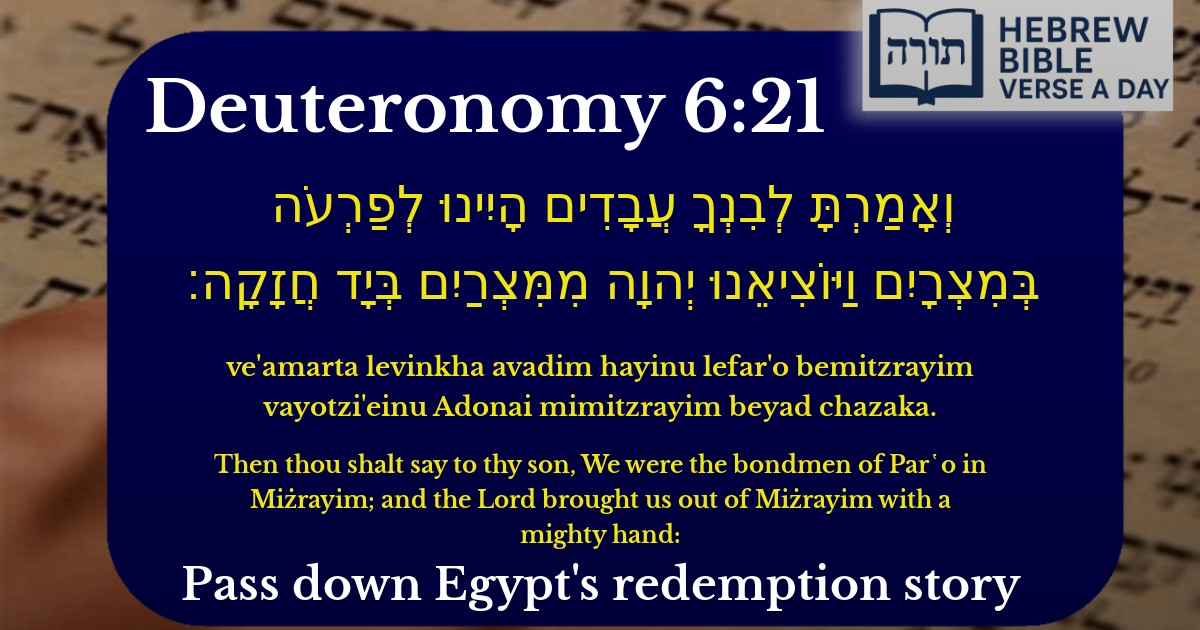Join Our Newsletter To Be Informed When New Videos Are Posted
Join the thousands of fellow Studends who rely on our videos to learn how to read the bible in Hebrew for free!
Hebrew Text
וְאָמַרְתָּ לְבִנְךָ עֲבָדִים הָיִינוּ לְפַרְעֹה בְּמִצְרָיִם וַיּוֹצִיאֵנוּ יְהוָה מִמִּצְרַיִם בְּיָד חֲזָקָה׃
English Translation
Then thou shalt say to thy son, We were the bondmen of Par῾o in Miżrayim; and the Lord brought us out of Miżrayim with a mighty hand:
Transliteration
Ve'amarta levinkha avadim hayinu lefar'o bemitzrayim vayotzi'einu Adonai mimitzrayim beyad chazaka.
Hebrew Leining Text
וְאָמַרְתָּ֣ לְבִנְךָ֔ עֲבָדִ֛ים הָיִ֥ינוּ לְפַרְעֹ֖ה בְּמִצְרָ֑יִם וַיֹּצִיאֵ֧נוּ יְהֹוָ֛ה מִמִּצְרַ֖יִם בְּיָ֥ד חֲזָקָֽה׃
Parasha Commentary
📚 Talmud Citations
This verse is quoted in the Talmud.
📖 Pesachim 116a
The verse is quoted in the context of the Passover Haggadah, where it is used to explain the obligation to recount the Exodus from Egypt during the Seder.
📖 Sotah 32b
The verse is referenced in a discussion about the importance of teaching children the story of the Exodus.


The Mitzvah of Recounting the Exodus
This verse (Devarim 6:21) is part of the obligation to recount the Exodus from Egypt, a fundamental mitzvah in Judaism. The Rambam (Hilchot Chametz U'Matzah 7:1) emphasizes that one must vividly describe the miracles and wonders performed for our ancestors in Egypt, as this reinforces our faith in Hashem and His providence.
Rashi's Explanation of "Avadim Hayinu"
Rashi comments that we begin by stating "We were slaves" to cultivate humility before recounting the redemption. This follows the Talmudic principle (Pesachim 116a) that one must begin with disgrace (genut) and conclude with praise (shevach). By acknowledging our former servitude, we properly appreciate the magnitude of Hashem's salvation.
The Significance of "B'Yad Chazakah"
The phrase "with a mighty hand" refers to the ten plagues, as explained by Ibn Ezra. The Sforno adds that this emphasizes Hashem's direct intervention against nature, demonstrating His absolute mastery over creation. The "mighty hand" symbolizes both the power displayed in Egypt and the ongoing Divine protection of the Jewish people.
Educational Methodology
The Mechilta (Bo 18) derives from this verse important pedagogical principles for teaching children about Yetziat Mitzrayim:
Contemporary Application
The Sefer HaChinuch (Mitzvah 21) explains that this commandment applies in every generation. By retelling the Exodus story with these prescribed details, we strengthen our connection to Jewish history and reaffirm our belief in future redemption. The Vilna Gaon notes that this verse establishes the framework for the Passover Seder's Maggid section.